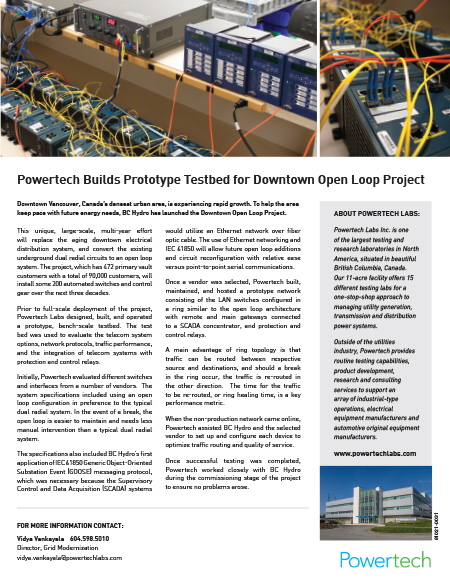
Downtown Vancouver, Canada’s densest urban area, is experiencing rapid growth. To help the area keep pace with future energy needs, BC Hydro has launched the Downtown Open Loop Project.
This unique, large-scale, multi-year effort will replace the aging downtown electrical distribution system, and convert the existing underground dual radial circuits to an open loop system. The project, which has 472 primary vault customers with a total of 90,000 customers, will install some 200 automated switches and control gear over the next three decades.

Prior to full-scale deployment of the project, Powertech Labs designed, built, and operated a prototype, bench-scale testbed. The test bed was used to evaluate the telecom system options, network protocols, traffic performance, and the integration of telecom systems with protection and control relays.
Initially, Powertech evaluated different switches and interfaces from a number of vendors. The system specifications included using an open loop configuration in preference to the typical dual radial system. In the event of a break, the open loop is easier to maintain and needs less manual intervention than a typical dual radial system.
The specifications also included BC Hydro’s first application of IEC 61850 Generic Object-Oriented Substation Event (GOOSE) messaging protocol, which was necessary because the Supervisory Control and Data Acquisition (SCADA) systems would utilize an Ethernet network over fiber optic cable. The use of Ethernet networking and IEC 61850 will allow future open loop additions and circuit reconfiguration with relative ease versus point-to-point serial communications.
Once a vendor was selected, Powertech built, maintained, and hosted a prototype network consisting of the LAN switches configured in a ring similar to the open loop architecture with remote and main gateways connected to a SCADA concentrator, and protection and control relays.
A main advantage of ring topology is that traffic can be routed between respective source and destinations, and should a break in the ring occur, the traffic is re-routed in the other direction. The time for the traffic to be re-routed, or ring healing time, is a key performance metric.
When the non-production network came online, Powertech assisted BC Hydro and the selected vendor to set up and configure each device to optimize traffic routing and quality of service.
Once successful testing was completed, Powertech worked closely with BC Hydro during the commissioning stage of the project to ensure no problems arose.
For more information contact:
Giuseppe Stanciulescu – 604.598.5011
Business Development Specialist
Business Development
email→
